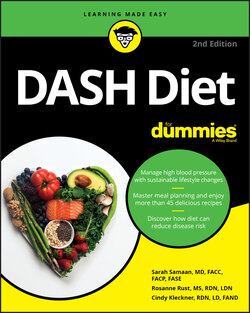Читать книгу DASH Diet For Dummies - Sarah Samaan - Страница 32
Conducting the research
ОглавлениеAfter all the subjects were recruited and screened, the fun began. In what was termed the run-in phase, everyone was given a standardized control diet for the first three weeks, which included all their meals and snacks. Next, each person was randomly assigned to spend eight weeks on one of the three experimental diets: control, fruits and vegetables, or DASH. All the food was prepared for them to keep everything as strictly regimented as possible.
Throughout the study, researchers measured the participants’ blood pressures at strict intervals, administered a questionnaire about symptoms and activity, and did urine tests to objectively assess potassium, magnesium, calcium, and protein intake (and to be sure everyone was onboard with the assigned diets).
In DASH, researchers kept the subjects’ calories constant throughout the study to keep body weight stable so they could evaluate the effect of the diet itself. Because they knew that weight loss lowers blood pressure, they had no reason to reinvent the wheel. (In reality, it’s easy to cut calories and lose weight on DASH, but that wasn’t the point of this particular study.)
The initial DASH study also kept sodium intake constant at about 3,000 milligrams per day. Although 3,000 milligrams is a pretty high daily dose of sodium, it’s still somewhat lower than the typical 3,400 milligrams found in a standard Western diet. To keep it simple, the DASH group wanted to first determine whether certain foods people eat may have an impact on blood pressure, regardless of salt.
The control diet: Because the control diet was designed to mimic a typical American diet, it included a hefty quantity of fat, plenty of meat, paltry amounts of fiber, and meager servings of fruits and vegetables. It was fairly low in potassium, magnesium, and calcium. In short, it was the type of diet that keeps cardiologists in business.
The fruits-and-vegetables diet: The fruits-and-vegetables diet group included on average more than 5 servings of fruit and more than 3 servings of vegetables each day, or nearly 2½ times the amount of plant-based food as the control diet. As a result, this diet supplied more than three times the amount of fiber as the control diet, and much more potassium and magnesium as well. This particular diet wasn’t designed to test a vegetarian diet, so it included about the same amount of fat and the same amount of meat, poultry, and fish as the control diet. However, it included one-third the number of snacks and sweets.
The DASH diet: In addition to incorporating the added fruits and vegetables, the DASH diet group included 2 servings of low-fat dairy per day, something neither of the other diets did. DASH dieters received about one-third the amount of meat as the other groups but similar quantities of poultry and a little more fish. Added fats, such as oils and salad dressing, were reduced by more than half, and sweets and snacks were severely curtailed.
